Juniper JN0-349 Exam Questions
Questions for the JN0-349 were updated on : Jul 02 ,2025
Page 1 out of 7. Viewing questions 1-15 out of 100
Question 1
What are two benefits of 802.3ad link aggregation? (Choose two)
- A. It increases bandwidth
- B. It ensures symmetrical paths
- C. It simplifies interface configuration.
- D. It creates physical layer redundancy.
Answer:
A, D
Explanation:
Aggregating multiple links between physical interfaces creates a single logical point-to-point trunk
link or a LAG. The LAG balances traffic across the member links within an aggregated Ethernet bundle
and effectively increases the uplink bandwidth. Another advantage of link aggregation is increased
availability, because the LAG is composed of multiple member links. If one member link fails, the LAG
continues
to
carry
traffic
over
the
remaining
links.
https://www.juniper.net/documentation/us/en/software/junos/interfaces-ethernet-switches/topics/topic-map/switches-interface-aggregated.html
Question 2
Click the Exhibit button.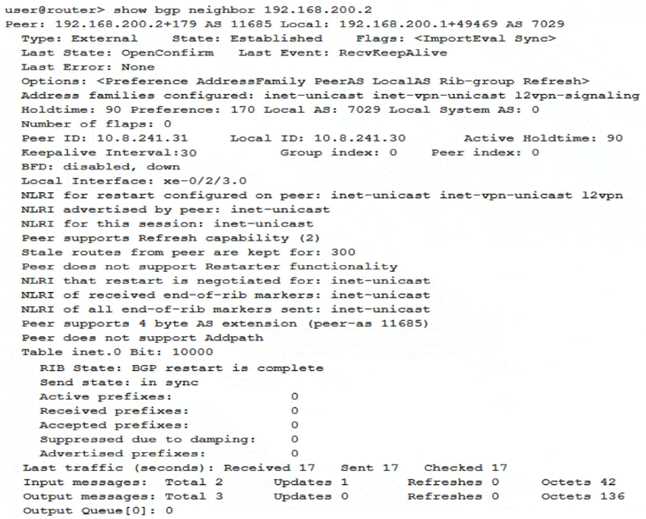
Your router is configured to peer with your ISPs router using BGP. You can only control your BGP
configuration.
Which address families are negotiated between the two BGP peers shown in the exhibit?
- A. inet-unicast inet-vpn-unicast 12vpn-signaling
- B. inet-unicast
- C. inet-vpn-unicast
- D. inet-unicast inet-vpn-unicast 12vpn
Answer:
B
Question 3
Which statement is true about IP-IP tunnels?
- A. Intermediate devices must have a route to the destination address of the traffic being tunneled.
- B. Intermediate devices must have a route to both the tunnel source address and the tunnel destination address.
- C. Intermediate devices must have a route to the tunnel destination address but do not require a route to the tunnel source address.
- D. Intermediate devices must have a route to the tunnel source address but do not require a route to the tunnel destination address
Answer:
B
Explanation:
Routing is based on destination, not source; Only the route for the destination tunnel endpoint is
necessary
for
each
packet.
If youre thinking about a lab environment with a single intermediary device, its incidental that it
will have a route for both tunnel endpoint IPs. Only the relevant destination will be considered with
each packet it processes.
Question 4
You have a conference room with an open network port that is used by employees to connect to the
network. You are concerned about rogue switches being connected to this port
Which two features should you enable on your switch to limit access to this port? (Choose two.)
- A. DHCP snooping
- B. dynamic ARP inspection
- C. MAC limiting
- D. 802.1X
Answer:
A, B
Question 5
Which two port security features use the DHCP snooping database for additional port security?
(Choose two.)
- A. dynamic ARP inspection
- B. MACsec
- C. IP Source guard
- D. MAC learning
Answer:
A, C
Question 6
You want to configure Layer 2 services over an IP-based tunneling mechanism between two sites.
Which configuration statement is required to accomplish this task?
- A. Set interface gr-0/0/0.0 family bridge
- B. Set interface ip-00/0/0.0 encapsulation valn-bridge
- C. Set interfaces gr—0/0/0.0 encapsulation vlan-bridge
- D. Set interface ip-0/0/0.0 family bridge
Answer:
A
Question 7
You are enabling dynamic ARP inspection on an EX4300 switch Which service is enabled by default in
this scenario?
- A. DHCP snooping
- B. persistent MAC learning
- C. MAC limiting
- D. IP Source Guard
Answer:
A
Question 8
Which two routers belong to the 172.16.0.0/22 aggregate route? (Choose two.)
- A. 172.16.4.0/24
- B. 172.16.0.0/24
- C. 172.16.5.0/24
- D. 172.16.3.0/24
Answer:
B,D
Question 9
What are two reasons for configuring more than one VLAN on a switch? (Choose two.)
- A. A group of clients requires that security be applied to traffic entering or exiting the group's devices
- B. A group of devices must forward traffic across a WAN.
- C. A group of devices are connected to the same Layer 3 network.
- D. A group of clients requires that the group's devices receive less broadcast traffic than they are currently receiving
Answer:
A, D
Question 10
Which two statements are correct regarding the root bridge election process when using ST P?
(Choose two )
- A. A lower system MAC address is preferred
- B. A higher bridge priority is preferred
- C. A lower bridge priority is preferred
- D. A higher system MAC address is preferred
Answer:
A, C
Question 11
What are two characteristics of OSPF ABRs? (Choose two.)
- A. ABRs transmit routing information between the backbone and other areas.
- B. ABRs cannot be part of the backbone and another area at the same time.
- C. ABRs inject information from outside the OSPF domain.
- D. ABRs link two OSPF areas
Answer:
A, D
Explanation:
Area border router (ABR): An OSPF router with links in two areas, the ABR is responsible for
connecting OSPF areas to the backbone. It transmits network information between the backbone
and other areas.
Question 12
Exhibit.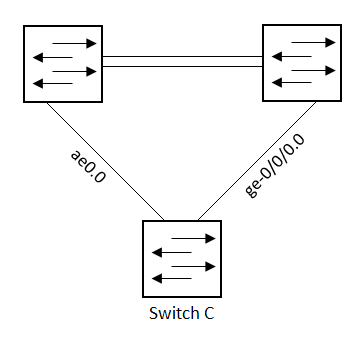
Referring to the exhibit, which configuration will force traffic to always use ae0.0 as long as it is
active?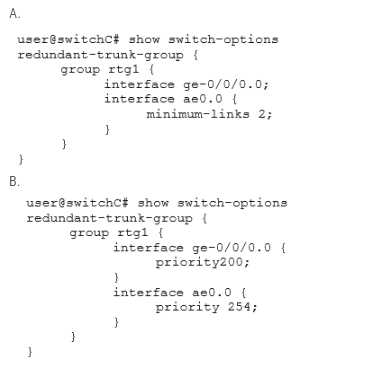
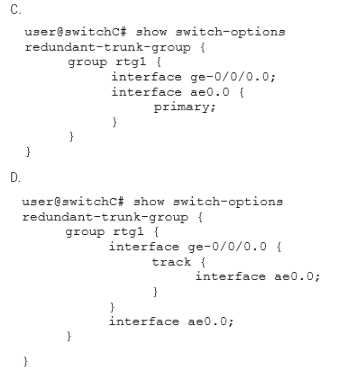
- A. Option A
- B. Option B
- C. Option C
- D. Option D
Answer:
C
Explanation:
https://www.juniper.net/documentation/en_US/junos/topics/topic-map/redundant-trunk-groups.html
1. set protocols rstp disable
2. set redundant-trunk-group group name interface interface-name primary
3. set redundant-trunk-group group name interface interface-name
4. option: set redundant-trunk-group group name preempt-cutover-timer seconds
Rapid Spanning Tree Protocol (RSTP) is enabled by default on EX Series switches to create a loop-
free topology, but an interface is not allowed to be in both a redundant trunk group and in a
spanning-tree protocol topology at the same time.
Question 13
Exhibit.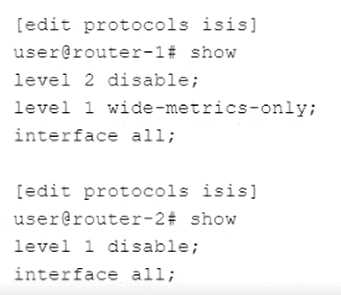
Click the Exhibit button Referring to the exhibit, what will be the IS-IS adjacency result of the
configurations?
- A. A level 1 and level 2 IS-IS adjacency will form
- B. A level 2 IS4S adjacency will form
- C. No IS-IS adjacencies will form
- D. A level 1 IS-IS adjacency will form
Answer:
C
Question 14
Which two sequences correctly describe the processing order of firewall filters on an EX Series
switch? (Choose two.)
- A. router filter > VLAN filter > port filter > transmit packet
- B. port filter > VLAN filter > router filter > transmit packet
- C. receive packet > port filter > VLAN filter > router filter
- D. receive packet > router filter > VLAN filter > port filter
Answer:
BD
Question 15
In which two STP states is a port active and a MAC address learned? (Choose two.)
- A. Blocking
- B. Forwarding
- C. Disabled
- D. Learning
Answer:
B, D